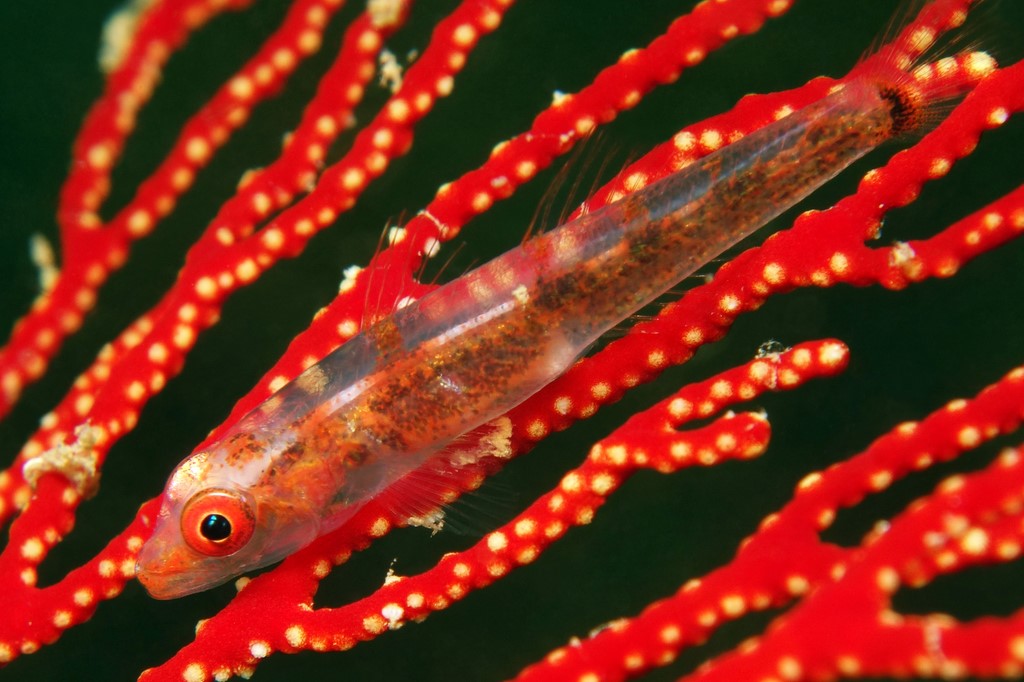BRYANINOPS YONGEI - (DAVIS & COHEN, 1969)
Picture courtesy of: Yves Thevenet
Actinopterygii (Gigaclass) > Actinopteri (Class) > Teleostei (Subclass) > Gobiiformes (Order) > Gobioidei (Suborder) > Gobiidae (Family) > Gobiinae (Subfamily) > Bryaninops (Genus)
Gobie nain de Yonge, Seawhip goby, Common whipgoby, Yonge's sea whip goby, Whip goby, Sea-whip goby, Whip coral goby, Garasuhaze, ガラスハゼ, 頦突珊瑚鰕虎魚
Synonymes
Bryaninops youngei (Davis & Cohen, 1969)
Cottogobius yongei (Davis & Cohen, 1969)
Tenacigobius yongei (Davis & Cohen, 1969)
-------------------------
Description
Dorsal spines (total): 7; Dorsal soft rays (total): 7-9; Anal spine: 1; Anal soft rays: 7-10; Pectoral fin rays: 13-17 rays, lower 3-6 rays unbranched and thickened toward tips. Longitudinal scale series 26-58 (usually: 40); Transverse rows of scales backwards: 3-16. Stocky-bodied, with lower margin of preopercle scalloped around 3-4 short grooves. Gill opening restricted to pectoral-fin base. Cup-like pelvic fins with pocket-like thickened, folded and lobed frenum; Tongue tip usually trilobed. Max. length: 3.5 cm SL. Depth range: 3 - 45 m.
Color
Head and body transluscent, with about 6 internal brown, golden or reddish bars (mimicking seawhip polyps); Vertebral column and abdomen silvery white to golden; Eyes bright gold to red-gold.
Etymology
Bryaninops: from the former similar or related genus Bryanina now, Sicyopterus + from Ancient Greek, óps = eye, face, appearance.
yongei: named in honor of British marine zoologist Sir Maurice Yonge (1899-1986), the authors’ shipmate on Cruise 6 of TE VEGA that collected type.
Original description: Cottogobius yongei Davis & Cohen, 1969 - Type locality: Darvel Bay, west of Tatagan Island, Borneo (off southeastern Sabah, Malaysia, Sulawesi Sea, western Pacific), depth 6 meters.
Distribution
Red Sea; Indo-West Pacific: KwaZulu-Natal (South Africa), Persian Gulf, Amirantes (Seychelles), Seychelles, Madagascar and Mascarenes (La Réunion, Mauritius), east to Hawaiian Islands (U.S.A.) and Marquesas Islands (French Polynesia), north to Kagoshima Prefecture (southern Japan), south to Western Australia, Queensland (Australia), New Caledonia, Tonga and Rapa (French Polynesia).
Biology
Lives exclusively on Cirrhipathes anguina (Dana, 1846) found along current-swept drop-offs or backreefs. Occurs in pairs, occasionally with juvenile or a smaller female. Also found on seaward and lagoon reefs. Feeds on zooplanktons. Benthic spawner. Bi-directional sex change may occur as suggested by a monogamous mating system and bisexual gonadal phase.
Last update: 26, May 2024
Actinopterygii (Gigaclass) > Actinopteri (Class) > Teleostei (Subclass) > Gobiiformes (Order) > Gobioidei (Suborder) > Gobiidae (Family) > Gobiinae (Subfamily) > Bryaninops (Genus)
Gobie nain de Yonge, Seawhip goby, Common whipgoby, Yonge's sea whip goby, Whip goby, Sea-whip goby, Whip coral goby, Garasuhaze, ガラスハゼ, 頦突珊瑚鰕虎魚
Synonymes
Bryaninops youngei (Davis & Cohen, 1969)
Cottogobius yongei (Davis & Cohen, 1969)
Tenacigobius yongei (Davis & Cohen, 1969)
-------------------------
Description
Dorsal spines (total): 7; Dorsal soft rays (total): 7-9; Anal spine: 1; Anal soft rays: 7-10; Pectoral fin rays: 13-17 rays, lower 3-6 rays unbranched and thickened toward tips. Longitudinal scale series 26-58 (usually: 40); Transverse rows of scales backwards: 3-16. Stocky-bodied, with lower margin of preopercle scalloped around 3-4 short grooves. Gill opening restricted to pectoral-fin base. Cup-like pelvic fins with pocket-like thickened, folded and lobed frenum; Tongue tip usually trilobed. Max. length: 3.5 cm SL. Depth range: 3 - 45 m.
Color
Head and body transluscent, with about 6 internal brown, golden or reddish bars (mimicking seawhip polyps); Vertebral column and abdomen silvery white to golden; Eyes bright gold to red-gold.
Etymology
Bryaninops: from the former similar or related genus Bryanina now, Sicyopterus + from Ancient Greek, óps = eye, face, appearance.
yongei: named in honor of British marine zoologist Sir Maurice Yonge (1899-1986), the authors’ shipmate on Cruise 6 of TE VEGA that collected type.
Original description: Cottogobius yongei Davis & Cohen, 1969 - Type locality: Darvel Bay, west of Tatagan Island, Borneo (off southeastern Sabah, Malaysia, Sulawesi Sea, western Pacific), depth 6 meters.
Distribution
Red Sea; Indo-West Pacific: KwaZulu-Natal (South Africa), Persian Gulf, Amirantes (Seychelles), Seychelles, Madagascar and Mascarenes (La Réunion, Mauritius), east to Hawaiian Islands (U.S.A.) and Marquesas Islands (French Polynesia), north to Kagoshima Prefecture (southern Japan), south to Western Australia, Queensland (Australia), New Caledonia, Tonga and Rapa (French Polynesia).
Biology
Lives exclusively on Cirrhipathes anguina (Dana, 1846) found along current-swept drop-offs or backreefs. Occurs in pairs, occasionally with juvenile or a smaller female. Also found on seaward and lagoon reefs. Feeds on zooplanktons. Benthic spawner. Bi-directional sex change may occur as suggested by a monogamous mating system and bisexual gonadal phase.
Last update: 26, May 2024
